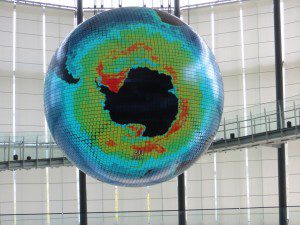
Miraikan is the National Museum of Emerging Science and Innovation in Tokyo. Tokyo has several science and technology museums, but with only two days in Tokyo we had to pick one. We were very pleased with our choice, although it just whetted our appetite for what else may be available in Tokyo.
1. The Museum must engage and excite – We had a wonderful time here, and kept spending longer than we had available on each exhibit. I found myself mesmerised by the gigantic globe (suspended from the ceiling) which has projections of different aspects of the globe. Declan had a great time designing a future city, Callum really enjoyed learning about the requirements for a habitable planet, and Evan enjoyed learning some quite sophisticated uses for mathematics (for example how best to extrapolate earthquake observations). Everything was in English and Japanese, which was handy for us gaijin. 9/10.
2. The exhibits must work and not baffle – Everything worked, which was great. There were, very occasionally, a few exhibits that you had to read Japanese to understand, but that’s hardly a black mark in a place in Japan! Sadly we did miss out on one of the best parts of this museum – the explainers – they were everywhere, giving talks, showing people exhibits, but all in Japanese. Seems unfair to mark it down for being Japanese, but this is about us. 9/10.
3. A play area should not substitute for teaching science in the museum. We didn’t find any specific play areas. Declan’s favourite city designing was a lot of fun, and also taught you some interesting things about Japanese innovations. The most playful area was a section showing how the internet worked using coded black and white balls, which the boys were both tempted to randomly press buttons at, but ended up figuring out what was going on despite themselves. The star of the show (and the most playful) was Asimo the robot, who bowed to us, stood on one leg, and even kicked a ball. 9/10.
4. Televisions and computers are no longer, in themselves, cool, or more generally, everything should be up to date. Here I was most impressed with the section on quantum computing, which not only explained it, but had interactive exhibits to help you understand what quantum computing could and could not do. That is as up to date as I ever seen. We also saw some excellent visualisations of greenhouse gas concentrations around the world, right up to last year, as well as a complete model of the international space station with interviews with some of the Japanese astronauts 10/10.
5. Museums should tell a story. This museum really shone here. The theme was innovation, and all of the exhibits managed to weave that in in some way. For example, there was a whole section looking at different innovations that had happened in Japanese industry, and pointing out how many of them were about taking two disparate pieces of information and paying attention to how they worked together. 9/10.
Overall 46/50. We are very tempted to revisit to see the things we missed, even though it will involve a complex trip on our way to the airport from Kyoto.
And for the practical things:
Cafe factor: There is a cafe on the top floor which looked quite reasonable with good Japanese fast food. We didn’t go in though, so I can’t vouch for it.
Expense: A basic visit was under A$20 for a family of four, which is about as cheap as it gets by worldwide standards. it is slightly more to go to whatever exhibition is on at the time (which we didn’t manage to d0).
Gift shop: We didn’t get to the gift shop, but from the one cool thing we did see from there, I suspect it is worth a look.